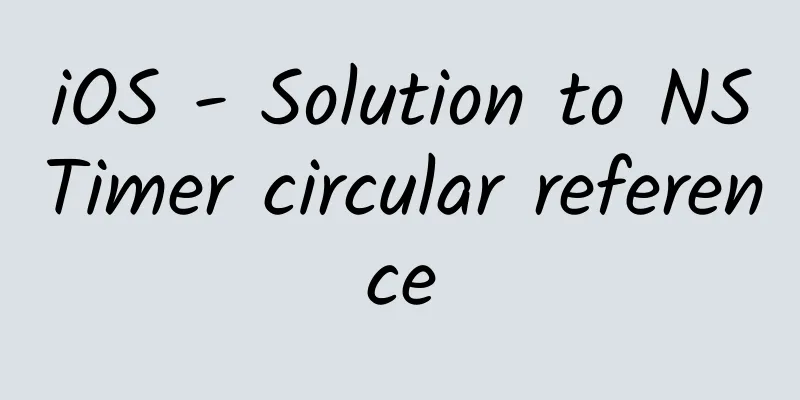iOS - Solution to NSTimer circular reference

|
Occurrence scenario In Controller B there is a NSTimer
You create it and attach it to the main runloop
Then when exiting Controller B, I forgot to turn off the timer. Controller B will not be released, and B and timer will have a circular reference because self is written directly into the timer when it is created. Method 1 Since we can't pass self directly, let's try passing weakSelf
The test result shows that a circular reference still occurs. B is not released, and timer has a strong reference to the weakSelf variable. Timer -> weakSelf -> B -> timer forms a circular reference among the three. Method 2 Set up a wrapper class, wrap Controller B and put it in the timer, like this I think Controller B is several MB in size, and leaking it is a waste of memory. WeakWrap is only a few hundred bytes, so it doesn't matter if it leaks. WeakWrap has a weak reference to Controller B. WeakWrap wraps Controller B and passes it into the timer. Even if you forget to turn off the timer, only WeakWrap and timer will be leaked. Theoretically, there are still memory leaks, but they are relatively rare. If a Controller is frequently entered and exited, one timer is lost every time it enters and exits. If there are dozens of leaked timers hanging on the main run loop, it will affect performance and smoothness. If you want dozens of timers to fire at the same time and call the timer event response method, the overhead is still quite large. Method 3 NSTimer is known to strongly reference the parameter target:self. If you forget to close the timer, anything you pass in will be strongly referenced. Just implement a timer. The function of a timer is to call a method at a fixed time. The calling time of NSTimer is not accurate! It is hung on the runloop and is affected by thread switching and the execution time of the previous event. Use dispatch_asyn() to execute functions at a fixed time. See the following code.
Dispatch_async loop does not generate recursive calls dispatch_async adds a task to the queue, and GCD calls back [weakSelf loop] This method solves the problem that the timer cannot be released and cannot be removed from the runloop. Using this method, I wrote a timer that does not have a circular reference. When the controller is released, the timer will also stop releasing automatically. You can even write self directly in the timer block without a circular reference. GitHub download address Method 4 I have never encountered the problem of circular references in NSTimer before, because I have always used them in pairs, opening them in viewWillAppear and closing them in viewWillDisappear. If they are not closed, so many timers mounted on the runloop will affect the performance and fluency. Just like managing memory, if the application and release are used in pairs, there will be no leakage. The principle of whoever applies should release. However, if the team is large, others may make mistakes and cause leakage, which can be solved from the technical point of view and the team programming standards. For example, some specifications are set, such as the controller must be successfully destroyed when exiting, and memory cannot be leaked. Self cannot be written in Block, etc. |
<<: When knowledge graphs “meet” deep learning
>>: Android resolution adaptation test
Recommend
Mante frog: colorful little "poisonous creature"
Cowan's Mantella, scientific name Mantella co...
China Automobile Dealers Association: Analysis of vehicle data for “Xing” certification week testing and certification
Affected by the continued impact of the local epi...
Douban’s methods and strategies for obtaining traffic!
Not long ago, Pinduoduo's market value surpas...
What are the cooperation platforms of Baidu Ai Procurement?
Since Baidu launched Aicaigou, many webmasters ha...
How will AutoNavi, which claims that it does not manufacture cars, transform the Internet of Vehicles?
Before November 2, if there was any news about Au...
What is server bandwidth? How many people can be online at the same time on a server with 1M bandwidth?
What is server bandwidth? The bandwidth of the se...
Eating cake = being poisoned? Does it really take 51 days to metabolize a mouthful of trans fatty acids?
Many people are familiar with "trans fatty a...
CRISPR patent battle: Zhang Feng wins! Nobel Prize winner team loses eukaryotic cell CRISPR patent
The patent dispute over the 2020 Nobel Prize-winn...
Detailed explanation of opening a Google account for Google promotion!
Google Ads is one of the more mainstream promotio...
Does the Earth need to wander? Have you ever seen a space elevator? Here's everything you want to know about "The Wandering Earth 2"
Is the Digital Life Project feasible? What is a r...
Hu Quan: Killer Applications in the Industrial 4.0 Era
In the era of Industry 4.0, from the perspective ...
Sony Xperia Z1 has a big system evolution but a small appearance change. Price: 4999 yuan
[September 9 news] September is a nightmare for m...
IDC: Global AI market size is expected to reach US$88.57 billion in 2021
Artificial intelligence (AI) technology has broad...
How do SEM bidders respond to company interview questions? A collection of interview secrets!
I believe that every SEMer works hard to optimize...
Is it worth a fortune to stay slim in old age? Even if you are thin, you must have muscles and bones!
As the saying goes, "It's worth a fortun...









